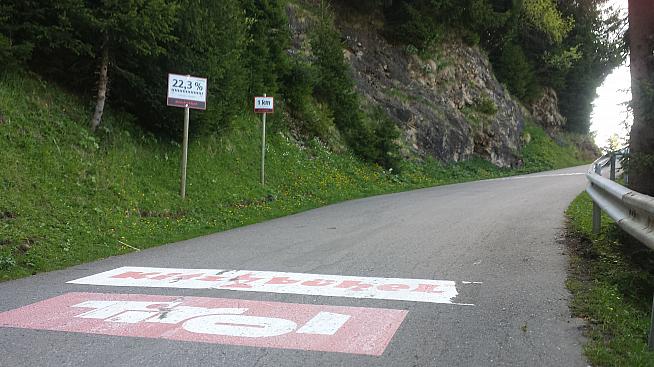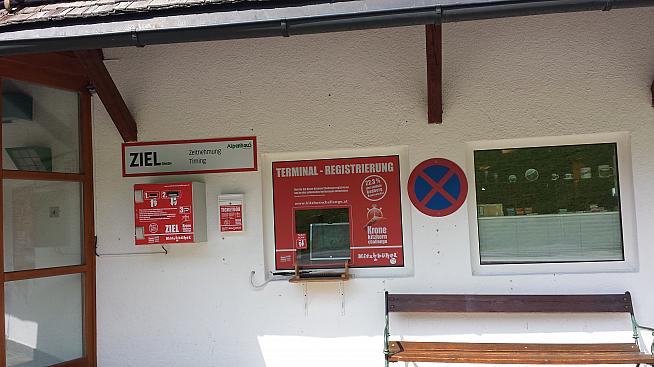Kitzbuehel is most famous for its skiing, in particular the legendary Hahnenkamm run, which is probably one of the toughest races in the World Cup season. It is less well known for its cycling, although this is a shame because it has some fairly amazing roads nearby it and a climb of epic proportions in the shape of the Kitzbuehel Horn. Perhaps it is because the Grand Tours take in the great climbs of France, Italy and Spain and they attract so much attention that the climbs of Germany and Austria get neglected, despite them being no less challenging.
Austria's two most challenging climbs are, according to locals at least, the Grossglockner and the Kitzbuehel Horn. With the Horn a quick 30km away from where I was staying in Germany on a family holiday, I decided to give it a spin one Sunday morning.
The ride starts on the north side of Kitzbühel, a small town which is home to some seriously expensive shops and houses. Among skiers it is an uber-wealthy resort and if you're thinking of making it your base for a few cycling trips then make sure you take out a second mortgage in advance. To find the start of the ride, head in the direction of St Johann in Tirol, along the A161 road. The route to the Horn is well signed off to the right - if you've gone past the red bridge you've missed it.
The early section of the climb off the main road is reasonably gentle and the road is painted with big HORN signs and arrows to show you where to go. Rolling through Alpine meadows, it is hard to imagine what comes next.
At a point 7.1km from the Alpenhaus Kitzbueheler Horn (which is where the main road ends) is a start line and ticket booth where you can get a free timing ticket for your ride.

There is also a board showing who holds the record for the climb - 28:24 by Thomas Rohregger in 1986 - which consists of 865 metres of climbing over 7.1km, an average gradient of 12.5%.

The climb from the ticket booth starts gently enough, for about 200 metres. And then it starts to rear up, hitting around 14% for 400 to 500 metres before settling down a little to about 12%. After about 2km there is a small relief as you pass the toll booth (for cars only that want to drive up) but after that the climb is pretty relentless.

With 1km to go the road really gives you a kick in the nether regions as it hits 22.3% for about 200 metres, which is really not much fun. After that ends it flattens out to about 12% to the Alpenhaus.

I would not be telling the truth if I claimed that I did the climb without stopping. And I didn't just stop to take photos of the climb for the edification of Sportive.com readers. I am reasonably fit - in training for La Marmotte - but I think I had to stop seven times over 7.1km, which is probably a bit pathetic but is also a reflection of how tough this climb is. Climb By Bike rate it as the 14th most difficult climb in the Alps, which given that some of them are basically vertical dirt tracks shows that this is a proper challenge.
If you're thinking of doing this climb I'd say the very minimum you want on the back is a 28 and you will definitely regret trying it with a 25, unless you are a really top level club cyclist.
The climb is well marked, both with signs every kilometre and also signs showing just how steep it is on the steepest sections, which was both informative and dispiriting.
When I got to the top I went to the machine to register my finishing timing - which you can then post onto a computer and then have your record posted online - but I had stupidly put my ticket in my back pocket (rather than in the zip pocket with my credit card and cash) and it was so sweaty that when I tried to post it into the machine it disintegrated in a soggy mess. Anyway, my time of 63 minutes was so slow that the machine probably would have laughed at me and asked whether I had walked up.

For the truly hard men and women of cycling, there is a path that keeps going higher still to the radio masts on the top of the Horn. However the path is usually full of hikers, is less than a metre wide and hits more than 25% at the top. In other words, unless you are there very early in the morning it might not be an ideal climb.

I had set off relatively early in the morning - I started the climb at 8.50am - so I wasn't overtaken by any other cyclists but about ten minutes after I got to the top another cyclist arrived looking fairly hot and bothered, threw his bike to the ground and then lay down on a bench panting for about two minutes. He'd managed the climb in 41 minutes and was on a club ride. His fellow riders gradually arrived, the next one about six minutes behind him.
At the top the nice Alpine restaurant would be a good place for lunch if you were there at the right time of day, although I was far too early and just got a Coca Cola to keep me going. The woman behind the counter also gave me a rather nice little sticker of the climb, which I have stuck on my garage door (she thought I should put it on my bike, which I decided not to tell her would be an act of heresy).
The descent was rapid, although because of an issue with a rear brake pad I wasn't going full pelt. It is what I think is termed 'technical' by the pros and because there had been a lot of rain in previous days it had a lot of debris and gravel, which is never good for speedy descending. Despite this, I was back on the main road just under 14 minutes later. Even on a warm day I definitely needed arm warmers and any colder conditions and I would have needed full gloves, rather than mitts. It is well worth consulting a weather forecast before starting the climb, because on the day when I wanted to try the climb a second time I got to the bottom in torrential rain and was warned by locals that it was trying to snow at the top and would be too dangerous to attempt.
Every July the town organises the Kitzbuehel Horn Mountain-Cycle Race which often attracts pro riders who have been riding the Tour of Austria. This year's race is on Saturday 24th July 2014 and entries are taken by organisers KitzSport up until an hour before the race.
0 Comments





